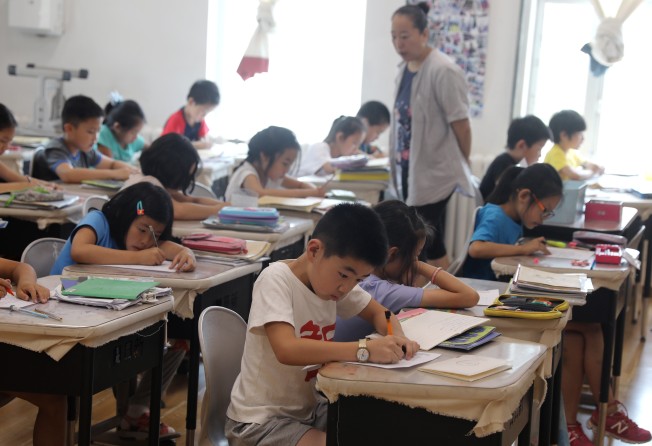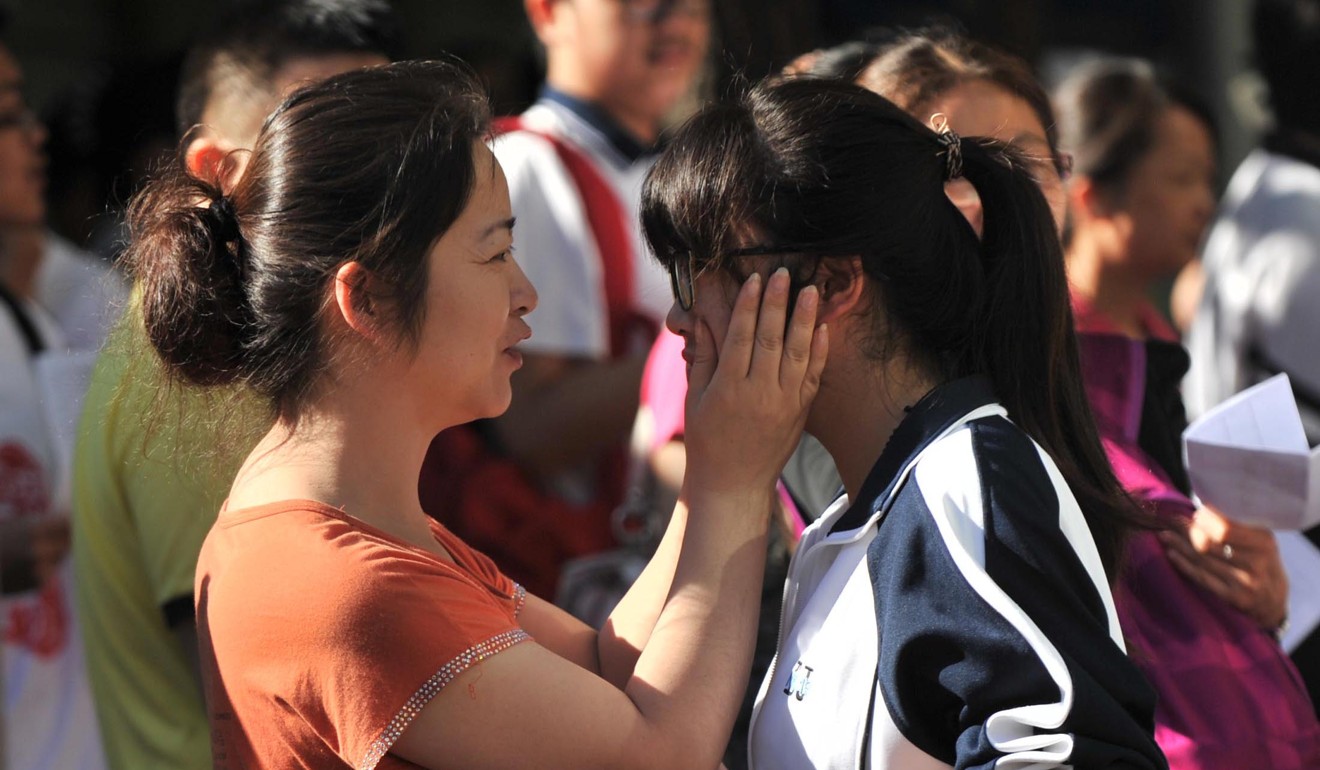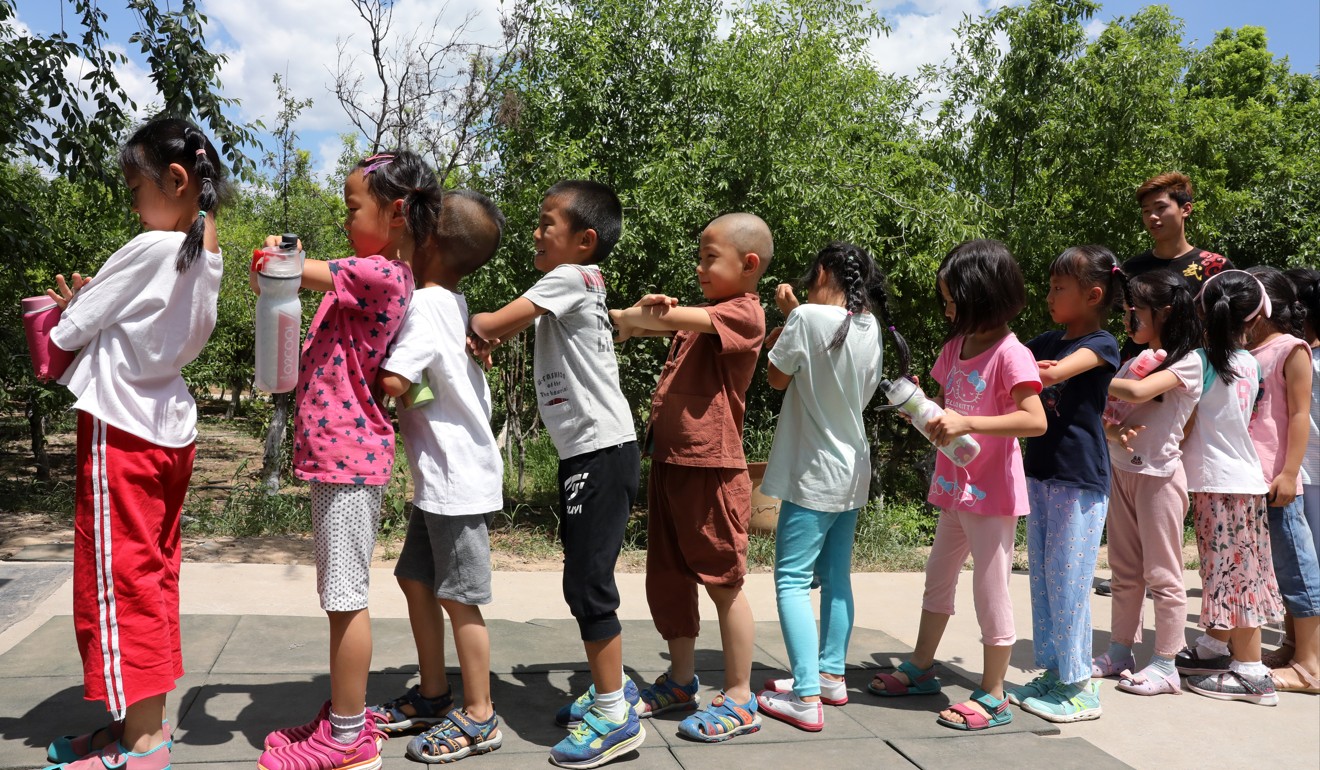
China’s middle class spend less as they scrimp and save for their children’s education
Parents prioritise school fees and tutoring costs but forgo other spending that the government is counting on to stabilise economic growth

China’s middle class is something of a mythical entity, with wide-ranging estimates of its size and economic power. Optimists believe a large and growing middle class has the ability to lift China and even the world to a more prosperous level, while pessimists foresee an increasingly burdened group that could cause the economy to stagnate and even lead to political chaos. In this, the last of a four-part series, the South China Morning Post continues to examine the myth to reveal the economic and political implications of its evolution.
It’s a Sunday afternoon, and Amy Jiang is rushing through a packed lunch with her seven-year-old daughter outside her classroom in a shabby building in Beijing. They are on a break between two lessons, each two hours, given by an after-school tutoring company.
Like millions of middle-class parents on the mainland, Jiang, a 35-year-old engineer, spends most of her weekends attending tutoring sessions with her child.
“I have to be here,” Jiang said. “Some topics are too advanced for kids to understand, such as permutations and combinations in maths, and classical Chinese.”
As the trade war with the United States continues to rage, China’s burgeoning middle class, people like Jiang, are seen by some as a potential white knight for its slowing economy. The purchasing power of the group – ranging from 100 million to 400 million people, according to different estimates – is widely believed to be ballast for the economy. But fresh signs show their high spending on education is sucking up an increasing portion of the family budget and constraining other consumption.

Investing in education
Studying a wider range of subjects in more depth than the public school syllabus requires and getting a head start by studying topics before they are covered in school have become common tactics used by parents trying to help their children compete in a challenging educational environment in China.
Beijing-based New Oriental and TAL Education Group, the two largest listed education companies, both reported accelerating double-digit revenue growth in the first half of this year. New Oriental said total student enrolment in academic subject tutoring and test preparation courses increased by 44.9 per cent year-over-year to 2.06 million for the quarter ended May 31. TAL, meanwhile, said total student enrolment surged by 88.7 per cent from a year earlier to nearly 2 million students in the same quarter.
“Chinese parents, especially the middle class, understand it’s hard to climb the ladder of success if children from ordinary families do not possess degrees from a good university,” Hu Xingdou, an independent economist, said. “Amid fear and anxiety, the middle class are pushing their children to study hard and are willing to save every penny to invest in education.”
In fact, parents around the world are going the extra mile to ensure their children have a good start in life. According to an HSBC report, the “Value of Education, Higher and Higher”, released in June last year, over half of the 8,481 parents surveyed in 15 countries and territories are paying for some sort of educational training for their children, and almost two-thirds are paying for private tuition or have done so in the past.
The highest proportions of parents with at least one child in paid-for education are in India (96 per cent), the UAE (93 per cent) and Indonesia (87 per cent), while the highest proportions of parents currently paying for private tuition (or who have done so in the past) are in mainland China (93 per cent), Indonesia (91 per cent), Hong Kong (88 per cent) and Egypt (88 per cent).
Chinese parents understand the competition is especially intense on the mainland. Their children will be competing with nearly 10 million peer students – more than the population of Hong Kong – in the national college entrance examination for the chance to be admitted to one of 150 tier-one universities. Their chances are less than 6 per cent, if history provides a guide. And the calculation excludes those from privileged or well-connected families who can be sure of being admitted.

China amended its compulsory education law in 2006, banning entrance exams for primary schools and junior middle schools to relieve the burden on young students. Since President Xi Jinping took office in 2013, he has underscored the need for equity and fairness in the nation’s nine-year tuition-free compulsory education system, emphasising a “more balanced” allocation of educational resources. Under that programme, students go to primary schools near their home and are enrolled in one of several nearby primary schools under a so-called computer allocated system.
But the rules for how the allocation is conducted have not been made public and the idea that it comes down to “luck” does not explain why children from well-connected families are always enrolled in better schools. As a result, middle-class parents pin their hopes on a few public middle schools that recruit high IQ students through tests in maths, Chinese and English for their special programmes.
“At least those tests are transparent and relatively fair. I know the chance is slim for her to get into a prestigious middle school,” Jiang said, watching her daughter Jiejie yawning after a hectic morning. “Eventually Jiejie will have to compete with other students in the university entrance examination and her fate will mainly be decided by the test scores. So it’s never too early to prepare for it,” she said.
‘Don’t call me middle class’
Jiang is from a rural part of northern Shanxi province, but she graduated from a top university in Beijing. Her annual income of 100,000 yuan (US$14,500) is twice that of the average urban worker’s in the city. That makes her a member of China’s so-called middle class of three million, with a yearly salary of between US$3,650 and US$36,500, according to the World Bank definition.
She attributes this success to the education she received. So now, Jiang spends 12,000 yuan a year on maths lessons for her daughter, 12,000 yuan on Chinese, and 25,000 yuan on English. On top of that, she has spent about 50,000 yuan on dancing and piano lessons for Jiejie, and 20,000 yuan on an overseas trip to help the child “gain some international experience”.
Education expenses account for about 30 per cent of her household income, she said.
“Don’t call me middle class – my husband and I have never bought any clothes priced higher than 100 yuan since we had Jiejie,” she said. “We’re saving every penny for our daughter, as education provides the only channel in China for ordinary people like me to secure a decent life in the future.”
According to a survey of nearly 52,000 parents across the nation, most of them middle class, conducted by website Sina.com in November, spending on education accounted for an average 20 per cent of household income.
About 90 per cent of preschool children and 81 per cent of K12 students, aged six to 18, have attended tutoring courses. Families with preschoolers spent an average 26 per cent of their income on education, while those with K12 children had education-related outlays of 20 per cent of their income. Of all the respondents, about 61 per cent said they had plans to send their children to study overseas.
Since 2013, Chinese spending on education, culture and entertainment, medical care and health has risen steadily, while that for food, tobacco, alcohol and clothing has been declining, official data shows.

“Many families are willing to pay a lot of money for education and related services such as tourism and entertainment,” Li Chao, an analyst with Huatai Securities, said. “Generally speaking, it’s a sign of consumption upgrading. The risk is when people don’t expect household income to rise, the high education expenditure, which they give the highest priority, will crowd out other spending.”
Retail sales growth, including goods and catering and excluding other services, decelerated from 10.2 per cent last year to 9.3 per cent in the first eight months of this year in nominal terms. The growth slowed from 9.1 per cent last year to 7.5 per cent this year in real terms, according to the calculation of UBS Securities economists led by Wang Tao. Weaker car sales accounted for more than half of the moderation, while spending on medicine, appliances and other goods slowed, as well.
Wang expects overall consumption growth to slow in 2018 and 2019. “As export and economic growth slows, wage and income growth is expected to weaken. At the same time, softer property sales and a smaller wealth effect (from the rising value of property), and tighter consumer lending should also have some negative impact on consumption,” she said.
Even with the government’s policy easing, the UBS economists expect real consumption growth to slow from 7.3 per cent this year – down from 7.5 per cent in 2017 – to 7 per cent in 2019, with the risk to the forecast more on the downside.
Ernan Cui, an analyst with consultancy Gavekal Dragonomics, said China’s consumers should be providing “a bit of ballast” amid the economic slowdown and escalating trade tensions with the US, as growth in household spending, which accounts for about 40 per cent of the economy, has run at or slightly above the rate of headline GDP growth since 2011, and is generally less volatile than investment spending.
“But the ability of consumers to help keep the economy on track has begun to look shaky,” she said, arguing that household spending is not keeping up with income growth, even as income prospects have dimmed due to slowing industrial profits and decelerating employment growth.
Private schools
Emma Li deleted two e-commerce apps from her mobile phone recently. The former employee of a US investment bank in Beijing used to regularly buy fashionable dresses, shoes and cosmetics, but that was before her son started at a private primary school this month. The tuition fee is around 300,000 yuan a year, excluding elective courses.
“There is no public primary school within a 5km radius of our home,” said Li, who lives in a suburban Beijing housing project with 150,000 people. “Besides, I want my boy to have some international exposure before sending him to study overseas, which is not an advantage offered by public schools.”
Middle-class and affluent families sharing Li’s mindset have been rushing to send their children to one of around 125 private schools in Beijing, or 200 in Shanghai. Although Chinese partners are required to preside over their operations to ensure that Chinese values and the Communist Party’s ideology are embodied in their courses, private schools have boomed in recent years.
Meanwhile, China has vowed to ban university textbooks that promote “Western values” and has de-emphasised the importance of studying English in public primary and middle schools. In 2015, then education minister Yuan Guiren told media: “Never let textbooks promoting Western values appear in our classes.”
For Li, that is a backwards step. “How can you compete with the world’s elite if you have no way to understand their values?” Li said, explaining why she chose a private school for her son that offers classes in English taught by foreign teachers.
“But the tuition fee is higher than our current family income,” she said. “I’ve been looking for a job for months but with no luck yet. All I can do now is save, save, save.”